by Akanksha Kakati.
We began our journey from Guwahati on a sunny Monday morning in December. The trip from Guwahati to the Saimika resort in Cherrapunji is approximately 145 km and usually takes about 4 hours non-stop. It, however, took us double the time getting there, owing to the numerous stops we made along the way to absorb the beautiful sights that Meghalaya had to offer.
Our first stop was at the Jiva Veg restaurant in Nongpoh, for coffee and some delicious sandwiches. After refreshments we drove a little further towards Umiam Lake or “Bara Pani” (which translates to ‘big water’) as it is popularly known, which is about 15 kilometres before Shillong. The lake has some overwhelming views and is a popular tourist destination for adventure activities such as boating, kayaking and water scooting.
The road to Shillong is lined with pine and cherry trees. The pine trees were covered with pinecones and the cherry trees were blossoming with beautiful pink flowers that enveloped over the road rendering a beautiful scene along the way. The NH6 that connects Guwahati to Shillong is fenced in many parts with small roadside vendors selling fresh fruits and vegetables, among other things. We advise fellow travellers to try some of the delightful fresh honey or zesty bamboo pickles that are sold at these stalls.

We encountered a short delay while entering Shillong due to a traffic jam. Shillong suffers from many such jams because of the heavy traffic, narrow roads and lack of parking space in the city. In order to resolve this problem, most of the roads there adhere to one-way traffic rules, while the traffic police manages the crossroads. We recommend crossing Shillong early to avoid the traffic.
After surviving the traffic into Shillong we had the fortunate opportunity to visit the house of the Governor of Shillong or the Raj Bhavan. The house stands as a silent witness to sundry events of the past century. It was originally the residence of the Chief Commissioner of Assam, when Assam was carved out from Bengal in 1874. Initially the building was made of stone, but when an earthquake struck Shillong in 1897, like most other buildings in Shillong, the residence of the Chief Commissioner was destroyed. The new Government House was rebuilt to be ‘earthquake proof’ in 1903. It was renamed as the Raj Bhavan in 1951 and became the residence of the Governor of Assam after independence. During the bifurcation of Meghalaya from Assam in 1972, Shillong became a part of Meghalaya, however, it was still the seat of the common Governor while preparations were underway to have state Governors for the new states.
Large sandstone pillars and iron fences adorn the entrance of the house and its grounds. Upon arriving at the Raj Bhavan we were greeted by uniformed guards and were asked to register our information into the visitors’ log. The driveway is hedged with tall pine trees and perfectly trimmed bushes that frame the perimeter of beautifully manicured lawns. While driving in we crossed a Gnat IE1210 Fighter Jet, lawns and a tennis court. When one arrives at the Raj Bhavan, one is transported to a bygone era of magnificent splendour and decorum, characteristic of the British Raj.
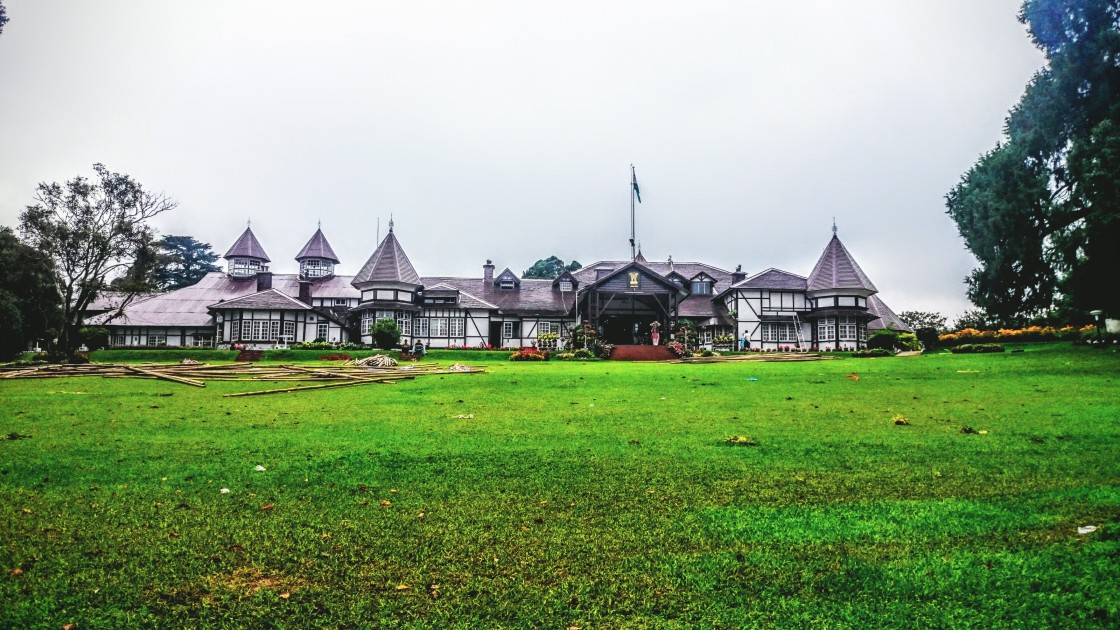
The roof of the house consists of six conical spires, while the rest is in the Gable style. The entrance to the building entails a covered porch supported by wooden beams and a wooden staircase overlaid on each side with beautiful seasonal flowers and ornamental cannons on top of the staircase. The entryway is a trove of a variety of brass ornaments, indoor plants and a large carpet on display. An Indian ceremonial brass lamp stands in the centre of the room. The following words are etched upon a plaque on the wooden beam of the entrance, “The good man is friend of all living beings”. The words echo the spirit of harmony and peace represented in the culture of Meghalaya.

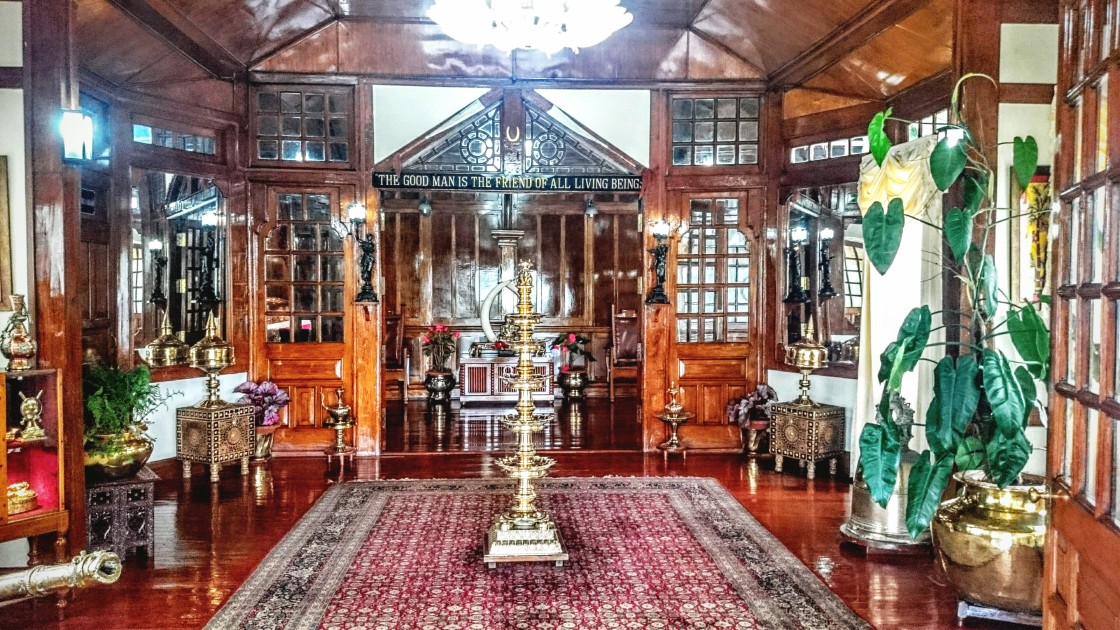
We subsequently stepped into the corridors of the house where even more ornaments adorn the hallways. A brass Buddha statue encircled by elephant tusks sits strikingly amidst other decorations. The walls are panelled with an array of teak wood. The Governor’s office, guest rooms and the Durbar Hall stand to the left of the corridor and the dining hall behind it, while the library and the living room are to the right of the corridor.
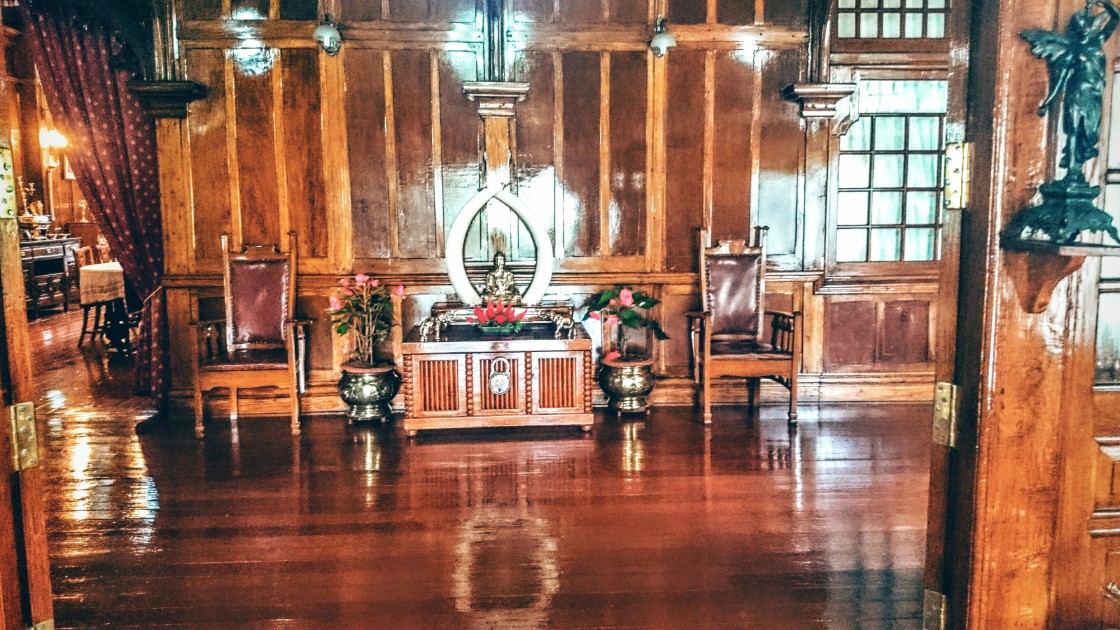
The library consists of high bookshelves housing many rare books and a comfortable seating plan. A fireplace embellishes the right side corner of the library, trimmed with wooden panels, old pictures and beautiful decorative vases.
Next we walked into the formal living room large enough to accommodate up to fifty guests. The room exhibits large French windows that open up onto the lovely flowering gardens.
The dinning hall is one of the most attractive rooms of the house. The large teak wood table, vintage chairs, chandeliers, silver cutlery and Victorian crockery only add to the elegance and charm of the room. The room was initially used as a ballroom but is now utilized for formal occasions such as state dinners.
We took a turn further ahead to join the guest wing of the house. There are seven guest rooms at the Raj Bhavan. The most impressive of these is the ‘Presidential Suite’, which is used to accommodate visiting dignitaries of States as well as officers of the Government. The guest rooms are beautifully decorated and equipped with modern fittings.
Further ahead is the auditorium or the Durbar Hall that is used for formal occasions such as swearing in ceremonies. There are two separate gallery seating arrangements, which are located to the left and the back of the auditorium.
After a tour of the house, we walked around the skilfully manicured lawns around the property. Sprawling lawns stand to the front of the house, surrounded by pine and other trees, with a fountain dancing rhythmically at the centre of it. The seemingly infinite gardens continue on and are separated between the upper and lower lawns. These are connected through a staircase. The upper lawns contain two summerhouses on each side of the staircase, with wooden pillars, thatched roofs and comfortable seating arrangements.
On the whole, the Raj Bhavan is a tranquil yet majestic piece of design and architecture that gives one a peek into the lifestyle and charm of a former time.

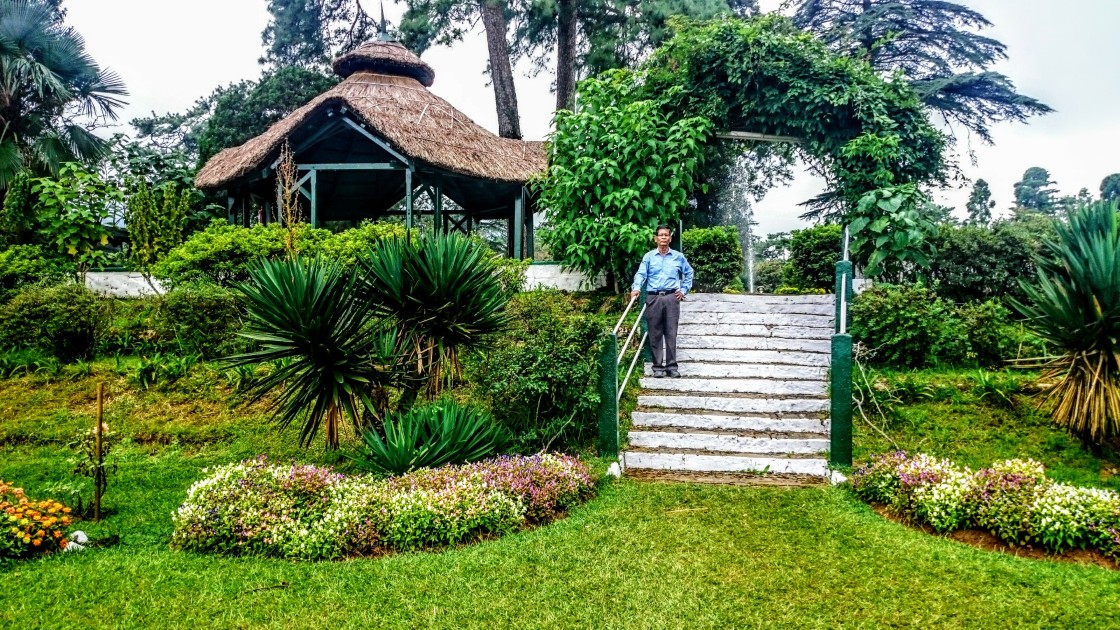
After a tranquil walk through times past, we were nudged back into the present at the progressive and lively Ward’s Lake. A popular destination for both tourists and locals, the Ward’s Lake has an interesting story behind it. According to the tale, a Khasi prisoner who was bored with the dreariness and tedium of the daily routine asked the warden for some artistic freedom. Having being granted permission the prisoner created the Ward’s Lake. Even so, the horseshoe shaped lake was created by Colonel Hopkins in 1894 and was named after the Chief Commissioner of Assam, Sir William Ward who commissioned the lake.

Two ends of the lake are connected via a wooden bridge. A ticket counter is located the latter end of the lake for tourists and paramours who are interested in boating. The edge of the lake is bordered with colourful boats. We enjoyed a pleasant boat ride over the lake. With the wind in our hair, we looked on at the scenic beauty before us. We bumped into approaching boats, spotted various fish, admired the sleeping ducks, revered the beauty of the various flowers surrounding the lake and giggled at the sweethearts trying to conceal themselves beneath the pine trees. We followed a cobbled path through the gardens surrounding the lake, which led us to a group of musicians sitting on top of a hill and taking turns to sing various rock songs. Meghalaya has a rich rock culture and one can here any one of the numerous rock classics in almost every nook and cranny of the state. Listening to the mellow music, time flew by and too soon we had to move on with our journey.
We went on from one aquatic body to another. The “Elephant falls” was originally known to the Khasi people as “Ka Kshaid Lai Pateng Khohsiew” (which translates to ‘three steps waterfalls’, because the water falls are divided in three sections). The waterfalls can be easily accessed via a series of steep winding steps, paths and a bridge. Upon arriving at the first waterfall, we came across a board that explains the reason for the name of the falls. Like many places in Meghalaya, it was renamed as Elephant Falls after British colonization. It was given the name because of a rock that looked like an elephant on the side of the falls. The rock no longer exists, as it was destroyed during an earthquake in 1897. The name, however, lives on.
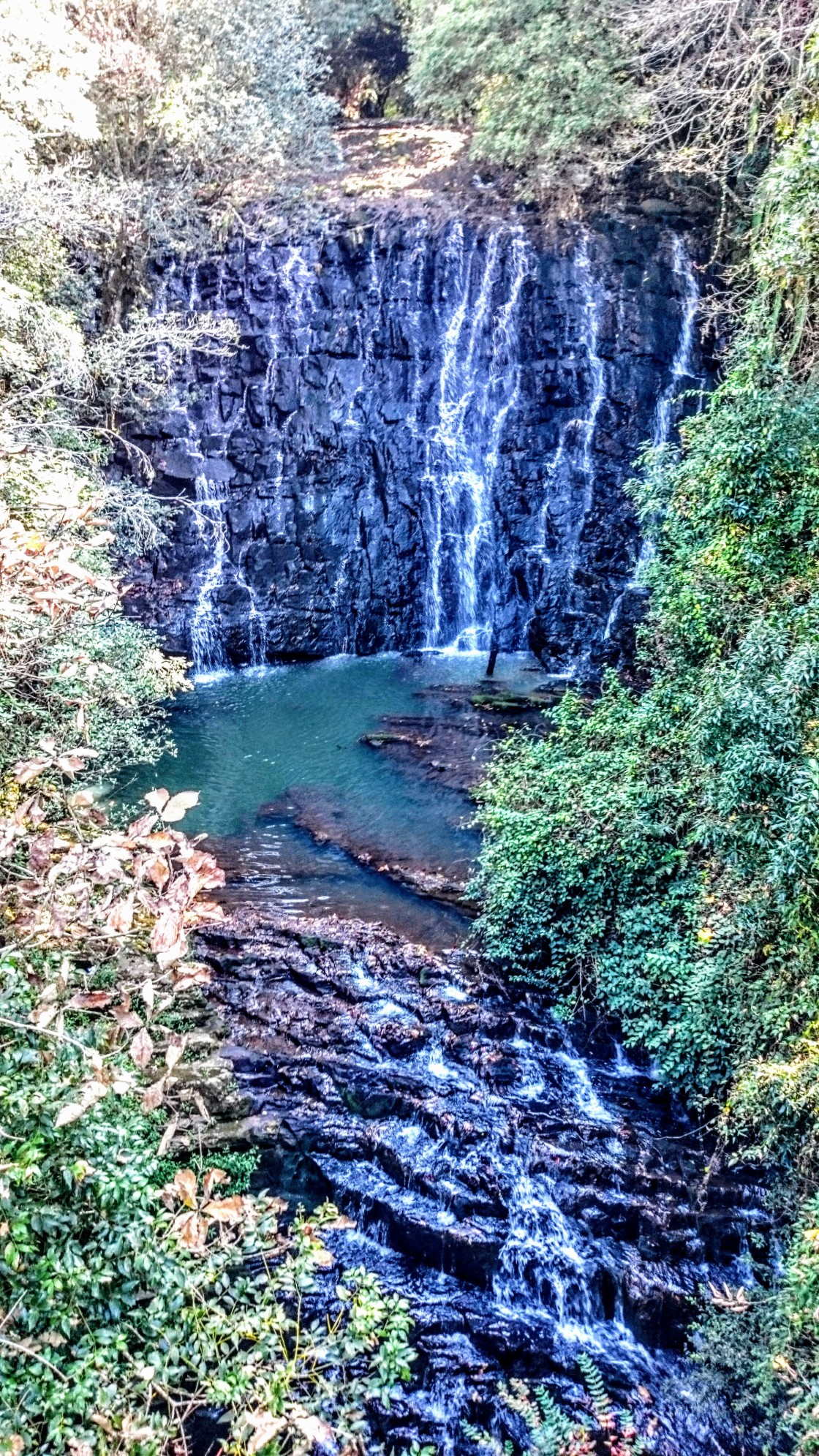
Trees surround the first and second waterfall. The second waterfall is a small one especially in the winter when the water levels are low. The bridge connects the path between the second and third waterfall. The third waterfall is the most remarkable of the three. It is steep with clear waters flowing over jagged rocks. The bottom of the waterfall is closed off with a rope to discourage tourists from wandering too close to falls. There is space near the shallow waters where tourists can take pictures and dip their feet into the water.
A small market stands at the entrance of the falls, where tourists can buy souvenirs such as toys, ornaments and bags made from bamboo as well as some exquisite preserved butterfly specimens indigenous to the area. There are also small cafes, at one of which we ate some chow mien for lunch. There are several Chinese restaurants in and around Shillong, but they cater mostly to tourists.
We happened upon a pleasant girl in small shop selling vegetables, from whom we purchased a handful of small potatoes and some “sohsaw” or tree tomatoes, which later turned out to be quite tender and delectable.
The forest cover of Meghalaya is around 69.5% and it is considered one of the lushest botanical habitats in Asia, owing to the diverse flora and fauna located here. A common misconception about north-eastern food is that it largely consists of meat. This idea however, is frequently invalidated, as many ethnic dishes are often comprised of the vast variety of exotic herbs and vegetables available (sometimes exclusively) in this part of the country.



















Awesome blog… Just loved it 😁
LikeLiked by 1 person
Thanks alot Protima. Keep reading our blog!
LikeLiked by 1 person